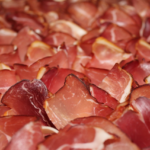If you’re an avid baker or cook, chances are you’ve used parchment paper in your kitchen. This versatile product is known for its non-stick surface and ability to withstand high temperatures, making it a popular choice for lining baking sheets, wrapping foods for cooking, and even as a piping bag.
But have you ever wondered if parchment paper is safe to eat? In this article, we’ll explore the composition of parchment paper, potential health concerns associated with its use, FDA regulations on its production and sale, alternatives to parchment paper, and how to choose safe options when using it in your cooking and baking.
Firstly, let’s dive into the composition of parchment paper. It’s made by coating a sheet of paper with silicone or quilon (a type of chrome-containing compound), which gives it its non-stick qualities. While both materials are considered food-grade safe by the FDA when used properly during production, there are still some concerns about potential chemical leaching into food during use.
As consumers become more aware of their exposure to chemicals in everyday products and their impact on our health and environment, it’s essential to understand the risks associated with using certain products like parchment paper.
Key Takeaways
- Parchment paper is popular for baking/cooking, but concerns exist about chemical leaching into food during use and harmful manufacturing processes.
- Conscious choices can reduce exposure to harmful substances while still enjoying delicious meals, such as using unbleached parchment paper made from natural materials like wood pulp/cotton fibers.
- FDA approval is crucial for ensuring the safety of food packaging materials, and checking for FDA approval is important before using parchment paper.
- Proper use and disposal of parchment paper can prevent potential harm and reduce environmental impact, including checking for recyclability and avoiding fancy decorated parchment paper with potential toxic inks.
Understanding Parchment Paper Composition
Did you know that parchment paper is made by coating a sheet of paper with silicone, making it non-stick and heat-resistant?
The parchment paper manufacturing process involves treating the paper with sulfuric acid to make it translucent. Then, the paper is coated with silicone to give it its signature properties.
While parchment paper is safe for use in cooking and baking, its production does have an environmental impact. The process of creating parchment paper requires chemicals such as sulfuric acid and silicone, which can be harmful to the environment if not disposed of properly.
However, many companies are working towards more sustainable manufacturing methods and using recycled materials to reduce their impact on the environment.
Health Concerns Associated with Parchment Paper
You may be surprised to learn about the potential dangers of using parchment paper in your kitchen. While it’s a handy tool for baking and cooking, there are some health concerns associated with its use. Here are three things to consider when handling parchment paper:
-
Safe Handling: Parchment paper is often coated with silicone, which can transfer onto your food if not handled properly. This can lead to silicone toxicity, which has been linked to nausea, vomiting, and diarrhea. To avoid this, make sure to handle the parchment paper with clean hands and avoid cutting or scraping it with sharp objects.
-
Impact on Environment: Parchment paper is not biodegradable and often ends up in landfills where it contributes to environmental pollution. Additionally, the production process of parchment paper involves bleaching agents that release harmful chemicals into the environment. To reduce your impact on the environment, consider using reusable silicone baking mats or unbleached parchment paper.
-
Sustainability: The demand for parchment paper has increased significantly over recent years due to its convenience in the kitchen. However, this demand has led to unsustainable practices such as clear-cutting forests for pulpwood production used in making parchment paper. It’s important to be mindful of our consumption habits and opt for sustainable alternatives whenever possible.
FDA Regulations on Parchment Paper
So, let’s talk about FDA regulations on parchment paper. As consumers, we want to make sure that the products we use in our kitchen are safe for us and our families.
That’s why it’s important to understand the standards for food-grade parchment paper and restrictions on harmful chemicals.
Standards for food-grade parchment paper
When purchasing parchment paper for cooking, it’s important to look for packaging that states the product meets food-grade certification. This indicates that the paper has been tested and approved by regulatory agencies such as the FDA and is safe for contact with food.
Additionally, food-grade parchment paper is made from natural materials like wood pulp or vegetable fibers, which reduces its environmental impact compared to other types of paper.
To ensure you are using safe and environmentally friendly parchment paper in your cooking, always check for food-grade certification on the packaging. Not only will this guarantee that your food won’t be contaminated with harmful chemicals or substances, but it also supports sustainable practices in the production of the paper itself.
By making conscious choices when selecting products like parchment paper, we can make a positive impact on our health and environment.
Restrictions on harmful chemicals
If you’re concerned about the chemicals used in food packaging, it’s important to know that there are restrictions in place to protect consumers from harmful substances. Food-grade parchment paper is no exception and must undergo rigorous chemical testing before it can be sold to the public.
This type of testing ensures that the paper does not contain any harmful substances such as heavy metals or toxic chemicals. In addition to protecting consumers, these restrictions also have an impact on the environment.
The process of making food-grade parchment paper without harmful chemicals requires careful consideration of raw materials, manufacturing processes, and waste management. By adhering to strict standards for chemical safety and environmental impact, manufacturers can ensure that their product is safe for consumption while minimizing harm to the planet.
Alternatives to Parchment Paper
So, we’ve talked about FDA regulations on parchment paper and its safety for consumption. Now, let’s explore some alternatives you can use in your baking endeavors.
Silicone baking mats are a popular choice that can be reused multiple times and provide a non-stick surface for easy removal of baked goods.
Aluminum foil is another option that can be used for lining pans or wrapping foods for cooking, but it may not be the best choice for delicate items due to its potential to tear or stick.
Wax paper is also an alternative, but it shouldn’t be used in the oven as it’ll melt and potentially ruin your dish.
Silicone baking mats
Silicone baking mats are a great alternative to parchment paper for those looking for a more durable and reusable option. Cleaning silicone mats is easy as they can be washed with soap and water or put in the dishwasher. They don’t absorb oils or butter, making them perfect for greasy foods like bacon or chicken wings.
The benefits of using silicone mats go beyond just being environmentally friendly. They also provide even heat distribution, preventing burnt spots on your baked goods. Plus, they’re non-stick so you won’t have to worry about your cookies sticking to the pan.
Silicone baking mats are definitely worth investing in if you want an alternative that’s not only safe to eat but also practical and long-lasting.
Aluminum foil
We just talked about silicone baking mats and how they can be a great alternative to parchment paper. But what about aluminum foil? It’s also commonly used in the kitchen, but is it safe to eat food that’s been cooked with it?
Using aluminum foil to cook or store food comes with some risks. Firstly, aluminum can leach into the food when heated at high temperatures. Secondly, if the foil is scratched or damaged in any way, it can release more aluminum into the food. This could potentially lead to health problems over time. While using aluminum foil sparingly may not have immediate negative effects on our health, it’s something to keep in mind when cooking or storing food.
When using aluminum foil, try not to let acidic foods come into direct contact with it as this increases the chance of leaching.
If you must use aluminum foil for cooking or storing food, make sure that it is intact and doesn’t have any scratches.
Consider investing in non-toxic alternatives such as reusable silicone bags or beeswax wraps for storing leftovers instead of relying solely on aluminum foil.
While convenient and widely available, using aluminum foil does come with some potential risks. By being mindful of how we use it in the kitchen and exploring alternatives when possible, we can reduce our exposure to harmful substances while still enjoying delicious meals.
Wax paper
Hey, you! Tired of using outdated and potentially harmful methods for storing your leftovers? Why not try wax paper instead?
Wax paper is a great alternative to aluminum foil when it comes to wrapping food items. It’s made by coating thin sheets of paper with a layer of wax, which makes it non-stick and easy to use.
Wax paper has a range of uses in cooking. It can be used as a lining for baking trays, as well as a wrapper for sandwiches and burgers. You can also use it to wrap cheese or butter that needs to be stored in the fridge.
Wax paper is an excellent option for microwaving food too, as it won’t stick or melt like plastic wrap does. So next time you’re looking for wax paper alternatives, give this versatile product a try!
How to Choose Safe Parchment Paper
When it comes to choosing safe parchment paper, there are a few key things to keep in mind. Firstly, we recommend looking for unbleached parchment paper, as it avoids the use of harmful chemicals.
Additionally, checking for FDA approval can provide peace of mind that the product has been deemed safe for consumption.
Lastly, it’s best to avoid colored or printed parchment paper, as these may contain dyes or other additives that could be potentially harmful.
By following these tips, you can ensure that your baking and cooking endeavors are both delicious and safe!
Look for unbleached parchment paper
To ensure the safety of your food, consider using unbleached parchment paper that resembles the color and texture of a rustic bread loaf. Unlike bleached parchment paper, which is treated with chemicals to achieve its white color, unbleached parchment paper is free from harmful substances that can potentially leach into your food during baking.
Not only is it safer for consumption, but unbleached parchment paper also has a lower environmental impact as it doesn’t produce toxic byproducts during its manufacturing process. Unbleached parchment paper is made from natural materials like wood pulp or cotton fibers. The absence of harmful chemicals in its production makes it an ideal choice for those who want to keep their food safe and healthy while being mindful of their impact on the environment.
So next time you’re shopping for parchment paper, consider choosing the unbleached option for a safer and more sustainable baking experience.
Check for FDA approval
It’s crucial to make sure any baking products you use have FDA certification, especially when it comes to parchment paper.
The FDA is responsible for regulating and ensuring the safety of food packaging materials, including parchment paper.
If a parchment paper product has been approved by the FDA, then you can be confident that it meets all safety guidelines and won’t cause any unexpected issues down the line.
However, not all consumers are aware of the importance of FDA certification when it comes to baking products like parchment paper.
It’s important to educate yourself on this topic so that you can make informed decisions about what products to use in your kitchen.
By checking for FDA approval before using parchment paper or other baking supplies, you’re taking an important step towards ensuring the safety and quality of your baked goods.
Avoid colored or printed parchment paper
Steer clear of fancy decorated parchment paper with colorful designs or prints, as they may contain harmful dyes that could potentially ruin the appearance and taste of your baked goods. It is important to read the labels carefully and avoid any product that does not explicitly state that it is made with food-grade materials.
Even though it might be tempting to use vibrant colored parchment paper for special occasions, it’s better to play it safe and stick to plain unbleached parchment paper. Avoiding toxic inks is crucial when selecting the right parchment paper for baking purposes. Toxic inks can seep into your food during the baking process and cause severe health problems if ingested.
Moreover, unbleached parchment paper has several benefits over bleached ones. They are free from any chemical additives that can harm your health or affect the quality of your baked goods. Unbleached parchment papers are also eco-friendly as they don’t require harsh chemicals during processing, making them a more sustainable option for everyday use.
Proper Use and Disposal of Parchment Paper
Using parchment paper properly and disposing of it in the correct way can help prevent any potential harm. When using parchment paper, it’s important to make sure that it isn’t used beyond its recommended temperature limit. This can cause the paper to burn and release harmful chemicals that could potentially be ingested.
It’s also essential to use unbleached parchment paper as this will reduce exposure to chemicals such as dioxins. Proper storage of parchment paper is also crucial in preventing contamination and prolonging the life of the product. Parchment paper should be stored in a cool, dry place away from direct sunlight or heat sources.
When disposing of used parchment paper, make sure to dispose of it responsibly by checking if your local recycling program accepts it. If they don’t, then put it in the trash bin instead of composting it as food particles may have contaminated the surface making recyclability difficult.
Being responsible with our usage and disposal of parchment papers can help reduce their environmental impact and keep us safe from chemical contamination.
Frequently Asked Questions
Is it safe to use parchment paper with acidic foods?
Using parchment paper with acidic foods may affect taste. Alternatives include silicone baking mats or greasing the pan. It’s important to note that while parchment paper is safe for cooking, it should not be eaten.
Can parchment paper be used in the microwave?
Let’s cut to the chase: using parchment paper in the microwave has its pros and cons. It can result in even cooking and easy cleanup, but be wary of overheating. For a safer option, try silicone baking mats or glass containers.
Can parchment paper be reused?
Yes, parchment paper can be reused for creative uses such as wrapping gifts or lining baking trays. However, its environmental impact is concerning, so consider using silicone baking mats or other reusable alternatives instead.
Is there a difference between bleached and unbleached parchment paper?
Did you know that bleached parchment paper has a higher environmental impact than unbleached? The production process for bleaching requires more energy and chemicals. Consider using unbleached parchment paper to reduce your carbon footprint.
How long can parchment paper be stored and still be safe to use?
Proper storage techniques are crucial for parchment paper to maintain its quality and shelf life. When stored in a cool, dry place, parchment paper can last up to 2 years. It’s important to avoid exposing it to moisture or direct sunlight.
Conclusion
Well, folks, we’ve got a shocking conclusion after diving deep into the world of parchment paper. Are you ready for it? Brace yourselves. Parchment paper isn’t safe to eat! Yes, you read that correctly.
That seemingly harmless roll of paper in your kitchen drawer is actually a danger to your health. But fear not! We’ve got some alternatives for you to consider: aluminum foil, silicone baking mats, or even good old-fashioned buttering and flouring your pans.
Just remember to always check the label and do your research before using any product in contact with your food. And please, for the love of all things delicious, don’t attempt to eat parchment paper. Trust us on this one.




